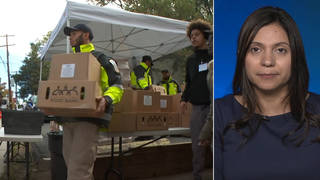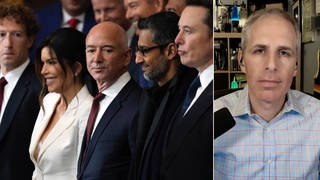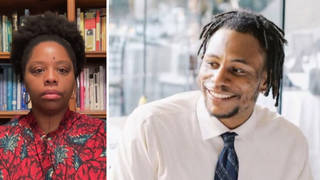
Guests
- Sonia Mercadocivil rights attorney representing the family of Ricardo Diaz-Zeferino.
After a two-year legal battle between the California city of Gardena and news outlets, a federal judge has ordered the release of police dash cam footage that shows local police officers shooting an unarmed man. In the video unsealed Tuesday, police order Ricardo Diaz-Zeferino and two other men to raise their hands in the air. The men comply. Diaz-Zeferino then lowers and raises his hands several times and removes his cap. His friends say he was trying to explain to the officers that they were on the streets looking for his brother’s stolen bicycle and were not bicycle thieves themselves as the cops incorrectly suspected. Three officers then open fire, killing him with eight bullets. They also wound one of the other men. The city of Gardena paid $4.7 million to settle a civil rights lawsuit with the victims’ families, but blocked release of the dash cam videos. In his ruling on Tuesday, Judge Stephen Wilson said there was a public interest in seeing the material. Gardena has since filed a notice of appeal with the Ninth U.S. Circuit Court of Appeals, which issued a stay suspending the release of the videos; however, the videos have gone viral and remain available online. For more, we go to Los Angeles, California, where we’re joined by Sonia Mercado, a civil rights attorney representing the family of Ricardo Diaz-Zeferino.
Transcript
JUAN GONZÁLEZ: After a two-year legal battle between the California city of Gardena and news outlets, a federal judge has ordered the release of police dash cam footage that shows local police officers shooting an unarmed man. In the video unsealed Tuesday, police order Ricardo Diaz-Zeferino and two other men to raise their hands in the air. The men comply. Diaz-Zeferino then lowers and raises his hands several times, and removes his cap. His friends say he was trying to explain to the officers that they were on the streets looking for his brother’s stolen bicycle and were not bicycle thieves themselves, as the cops incorrectly suspected. Three officers then open fire, killing him with eight bullets. They also wounded one of the other men.
AMY GOODMAN: The city of Gardena has paid $4.7 million to settle a civil rights lawsuit with the victims’ families, but blocked release of the dash cam videos. In his ruling Tuesday, Judge Stephen Wilson said there was a public interest in seeing the material. Gardena has since filed a notice of appeal with the Ninth U.S. Circuit Court of Appeals, which issued a stay suspending the release of the videos; however, the videos have gone viral and remain available online.
For more, we go to Los Angeles, California, where we’re joined by Sonia Mercado, a civil rights attorney representing the family of Ricardo Diaz-Zeferino.
Sonia Mercado, welcome to Democracy Now! Talk more about this case. I mean, you have Ricardo Diaz-Zeferino dying two years ago. Explain the circumstances and now the video being released. And we see him with his hands in the air, and we see this level of confusion, and then we see him gunned down by the police.
SONIA MERCADO: Yes, and to follow up on what the prior person was speaking about, the issue of the video cams are critical. One correction I’ll make is, the plaintiffs’ attorneys fought for two years to try and get the video cam. We never obtained—we obtained a copy of the video, but we never were allowed to release it to the public. A few months ago, about two months ago, the Los Angeles Times, after we settled the case, moved to obtain a copy of the video, which the department had always claimed was private and they wanted to keep secreted.
The critical aspect of that is, just as in the prior case, there was a video taken by a private person, therefore it’s not the property of the police department. As the nation moves towards the question of having every officer either wear a video cam on themselves or have a camera on a car, that becomes critical because what they will do, and have been doing, is saying, “We will show the public the video, only when we deem that they should see it,” which means that in cases like the young woman whose face was smashed against the ground, or my client, the public could never see what my client really had done this evening. Our position was that the video will show the truth, and therefore we believe that in a system of justice such as ours, the truth speaks for itself. These videos that now will be taken by either an officer wearing a video cam or a car cam, those videos must be made public. The reason they must be made public is, for example, in our case, up to the very day that the—the day that the judge released this video to the public after the Los Angeles Times filed their motion, the Gardena Police Department—the Gardena Police Department took the position that they had done nothing wrong. As we speak, they have taken the position that the officer did nothing wrong. And we see Mr. Zeferino clearly moving his hands only to try to explain to the officer that his two friends were not his brother’s bike thief.
JUAN GONZÁLEZ: Now, this happened two years ago, and the city settled, a huge settlement, obviously, with your client’s family, and yet news about this only surfaces in a major way once this video is released. Could you talk about what kind of attention it got at the time when he was killed?
SONIA MERCADO: Well, at the time that he was killed, the only news outlet reported what the police said. And what the police said was that these—that they suspected somebody of a burglary and that they suspected that my client was a burglar, and that the person was not obeying police directions. And that was all they said. The inference is to the public that this was probably a criminal, and he deserved to be killed. Whether that’s true or not, as a civil rights attorney, we know that that’s not the issue.
Another really critical thing we see in the video, which is why these videos must be shown, is that the officers are standing with their guns pointed at my clients, that two of the other gentlemen at no time move their hands—they were always above their head—and yet one of them was shot in the back. So it was not an issue that they weren’t paying attention or following police orders.
And secondly, critical, the officers are standing directly in front of our clients. Every officer is trained on day one in the academy that you take coverage if you’re in fear. If an officer is not in fear, then he’ll stand in front of the person and, you know, give them orders. The fact that they’re standing in front of our clients really shows that these officers were not in fear of their life; otherwise, they would have been behind their car vehicle and taking coverage. That’s important because the spin on the story up to now was that my clients had posed a threat of harm to the officers and that the officers were afraid for their lives, which is when an officer can shoot. And clearly there are circumstances when an officer is afraid for his life. But in this video, we see there’s no fear. And if they’re saying they’re afraid for their life, then clearly they’re being extremely dishonest. The critical—
AMY GOODMAN: This is Gardena Police Chief Ed Medrano. Speaking to NBC4 News, he suggests the police officers were justified in their actions.
POLICE CHIEF ED MEDRANO: He was not complying with his orders, and the officers could not see his hands at one point. The detailed analysis is in the district attorney’s opinion letter. We understand this is a tragic incident and they were the wrong people. But this case has been litigated for a number of years, and those officers only had seconds to make a split-second decision.
AMY GOODMAN: Gardena Police Chief Ed Medrano also said he disagrees with the judge’s orders to release the police officers’ dash cam video.
POLICE CHIEF ED MEDRANO: We don’t want our community members to feel distrustful of us because they know at some point their situation may end up on video or on the Internet.
AMY GOODMAN: That’s Gardena Police Chief Ed Medrano speaking to NBC4 News. Sonia Mercado, very quickly, your response to him, and also if you could tell us what happened on that day? Explain what these three men were doing, that they were looking for a bicycle thief.
SONIA MERCADO: First of all, my client, the gentleman, Zeferino, whom they killed, had worked 12 hours before this incident. All three of them had been working in a restaurant and left work around midnight, some 12:00, 12:30, and they were having some drinks and playing pool at a local tapas bar before they headed home. All three of them were on foot. Two were on bicycle. These were—my client had had some drinks, but he was walking home. What they were doing was resting a little bit before they went home after a long day’s work.
Listening to Chief Medrano is really sad, because what he says is—he continues spinning the facts. He says, “At one point we couldn’t see his hands.” However, when you look at the video, which is why it’s critical to see these videos, you see that Mr. Zeferino’s arms are clearly empty, that all three officers testified in depositions that they knew his hands—he didn’t have a gun in his hand. One of them said, “Well, I didn’t know if he didn’t have a gun in one hand.” So there’s a spin of facts.
And we just believe that it is critical for the public to know these were just three guys on their way home, had done nothing wrong. The officers were not listening to them, were ignoring them, and were—the other very important point in these cases is that the guns that officers are using now are very—it’s a hair trigger. So they pull their gun—my client was shot eight times. And these bullets are bullets that open up into their body once it enters the body, which is why these gentlemen who get shot by these police officers die right away. So, those are important points to remember when Chief Medrano is saying that they weren’t paying attention and that the district attorney really examined the facts. That’s also a sad statement, because the facts are that the district attorney merely accepted whatever report was produced to them by this very police department.
AMY GOODMAN: Sonia Mercado, we just have 10 seconds. Are these officers still on duty?
SONIA MERCADO: All officers have always been on duty, and every time they participated in any legal proceeding, they were paid time and a half.
AMY GOODMAN: Even though the city has settled for $4.6 million.
SONIA MERCADO: They were paid in the legal matter time and a half before they settled the case. They’ve always been on duty. They were given two weeks, what we call a vacation to the beach, and then they were back on duty, always on full pay.
AMY GOODMAN: Sonia Mercado, we want to thank you for being with us, civil rights attorney representing the family of Ricardo Diaz-Zeferino, gunned down by police two years ago. We now have the videotape. And for those listening on the radio, you can go to democracynow.org and see it. This is Democracy Now! Speaking of gun violence, we’re going to talk about that in Chattanooga, Tennessee, in a moment.












Media Options